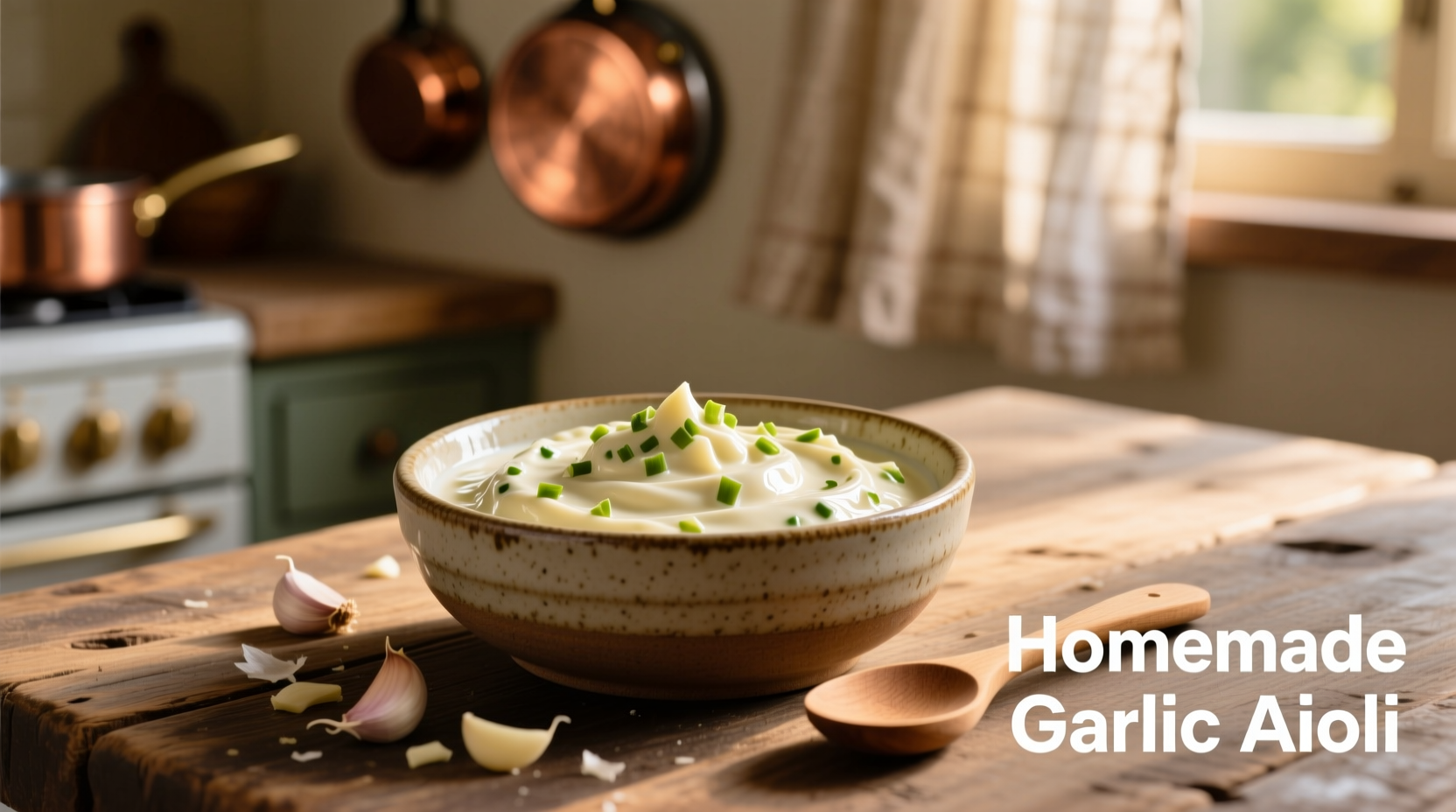Master the art of authentic garlic aioli with this comprehensive guide. You'll learn the historical roots of this beloved sauce, discover why traditional preparation methods yield superior results, and gain practical techniques to create perfect aioli every time. Whether you're a home cook or culinary enthusiast, this guide delivers actionable insights you can implement immediately.
The Evolution of Garlic Aioli: From Ancient Tradition to Modern Kitchen
Aioli's journey spans centuries, evolving from a simple garlic and oil mixture in Mediterranean coastal regions to the beloved condiment we know today. Originally created by laborers who needed portable, energy-dense food, traditional aioli required significant time and effort to prepare properly.
| Era | Preparation Method | Key Ingredients | Cultural Significance |
|---|---|---|---|
| Ancient Mediterranean | Mortar and pestle | Garlic, olive oil, salt | Staple food for laborers and fishermen |
| 18th-19th Century | Wooden mortar refinement | Garlic, olive oil, egg yolk | Regional specialty in Provence and Catalonia |
| Early 20th Century | Whisk introduction | Garlic, olive oil, egg yolk, lemon | Spread through European culinary traditions |
| Modern Era | Blender/food processor | Garlic, olive oil, egg yolk, acid | Global culinary staple with countless variations |
According to culinary historians at the University of Barcelona's Food Science Department, traditional aioli's emulsion process creates a more stable and flavorful sauce than modern mechanical methods because the gradual incorporation of oil allows for better molecular bonding. This explains why handmade aioli maintains its texture longer and delivers more complex flavor development.
Traditional vs. Modern Preparation: What Really Matters
The fundamental difference between authentic aioli and modern interpretations lies in the emulsification process and ingredient quality. Traditional aioli requires patience and technique, while modern versions often sacrifice flavor complexity for convenience.
When preparing garlic aioli, certain conditions significantly impact the final product. Temperature matters most—both ingredient temperature and kitchen environment. Professional chefs at Le Cordon Bleu culinary institute note that aioli made with room-temperature ingredients in a kitchen below 75°F (24°C) achieves optimal emulsion stability. Higher temperatures cause the emulsion to break more easily, while colder ingredients prevent proper bonding.

Perfect Garlic Aioli Recipe: Step-by-Step Guide
Creating exceptional garlic aioli requires attention to detail at every stage. Follow these professional techniques to achieve restaurant-quality results at home:
- Prepare your garlic: Use 2-3 fresh garlic cloves per serving. Peel and mash with 1/4 teaspoon salt into a smooth paste using a mortar and pestle. This releases garlic's essential oils without bitterness.
- Emulsify carefully: Add one large egg yolk to the garlic paste. Whisk continuously while very slowly drizzling in extra-virgin olive oil (about 1 cup per yolk). Start with drops, then increase to a thin stream.
- Maintain proper temperature: Keep ingredients at room temperature. If the kitchen is warm, place the bowl in a larger bowl with ice water to maintain optimal emulsification temperature.
- Adjust consistency: If the aioli becomes too thick, add 1-2 teaspoons of warm water or lemon juice to loosen it. Never add cold liquid, which can cause separation.
- Season thoughtfully: Finish with freshly squeezed lemon juice (about 1 tablespoon) and adjust salt to taste. Let rest for 30 minutes before serving to allow flavors to meld.
Essential Pairings: What to Serve with Garlic Aioli
Garlic aioli's versatility makes it suitable for numerous dishes, but certain pairings showcase its flavor profile best. Culinary experts at Spain's Basque Culinary Center recommend these classic combinations:
- Seafood: Grilled fish, shrimp, or octopus—aioli complements without overpowering delicate flavors
- Vegetables: Roasted asparagus, artichokes, or grilled mushrooms create perfect flavor harmony
- Sandwiches: Elevates chicken, turkey, or vegetable sandwiches with creamy richness
- Tapas: Traditional with patatas bravas or croquettes for authentic Spanish experience
- Grilled meats: Pairs beautifully with chicken, pork, or lamb when balanced with acidic elements
Common Variations and Creative Adaptations
While traditional garlic aioli remains timeless, these thoughtful variations can enhance specific dishes:
- Lemon-herb aioli: Add fresh parsley, chives, and extra lemon zest for seafood dishes
- Roasted garlic aioli: Substitute raw garlic with roasted cloves for milder, sweeter flavor
- Spicy aioli: Incorporate a pinch of cayenne or smoked paprika for heat dimension
- Truffle aioli: Add a few drops of truffle oil for upscale presentations
- Preserved lemon aioli: Mix in finely diced preserved lemon for Mediterranean flair
Storage Guidelines and Shelf Life
Proper storage maintains garlic aioli's quality and safety. Since traditional aioli contains raw egg, follow these guidelines:
- Store in an airtight container in the refrigerator below 40°F (4°C)
- Consume within 3-4 days for optimal freshness and safety
- Always use clean utensils when serving to prevent contamination
- Discard if you notice separation that doesn't reincorporate with stirring, off odors, or color changes
Food safety experts at the USDA note that homemade aioli with raw eggs carries potential food safety risks, particularly for vulnerable populations. For extended storage or serving to at-risk individuals, consider using pasteurized eggs or creating a cooked aioli variation.
Troubleshooting Common Aioli Problems
Even experienced cooks encounter issues with aioli preparation. Here's how to fix common problems:
- Broken emulsion: Start with a fresh egg yolk in a clean bowl, then slowly whisk the broken aioli into the new base
- Too garlicky: Balance with additional lemon juice or a touch of honey to mellow the flavor
- Too thin: Continue adding oil slowly while whisking vigorously to thicken the emulsion
- Bitter taste: Caused by over-processing garlic—start again with freshly minced (not pureed) garlic
- Separation during storage: Gently stir or whisk to reincorporate; if unsuccessful, create a new emulsion base











 浙公网安备
33010002000092号
浙公网安备
33010002000092号 浙B2-20120091-4
浙B2-20120091-4